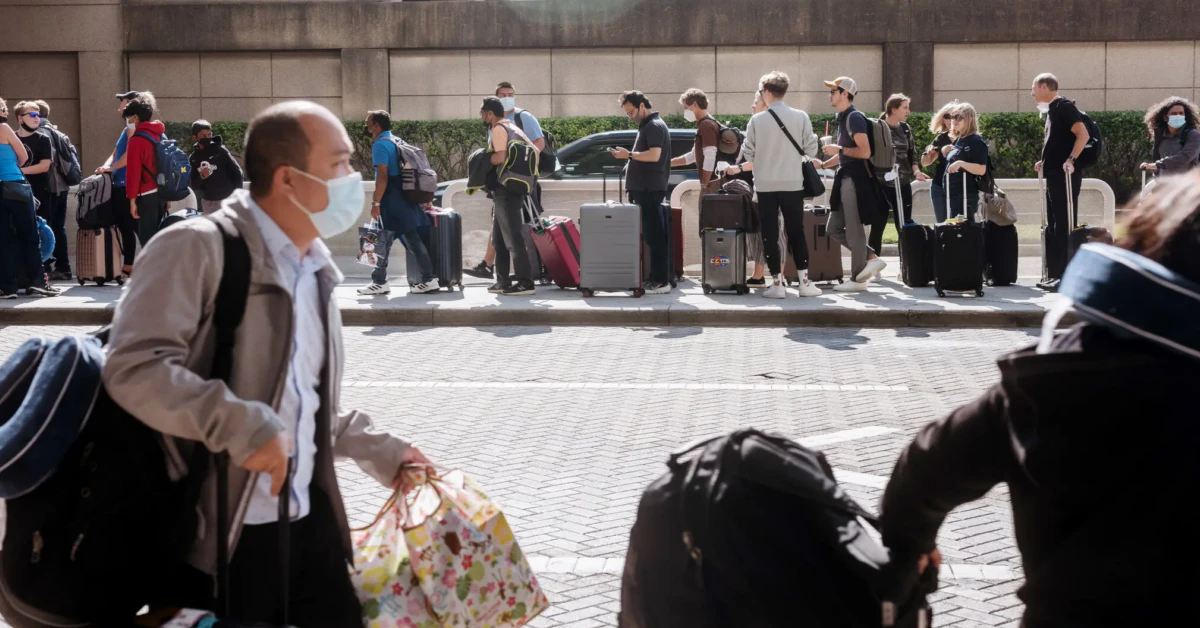Nobody wants to be the person who drags up the pandemic again in 2025. But if your flight was packed with sniffly passengers last week or your coworker called out sick with a fever “out of nowhere,” you’re not imagining it.
The U.S. is officially in what experts are calling a “summer wave.” Not a tsunami—yet—but more like a riptide we can’t ignore. Let’s dive into what’s real, what’s myth, and why your next move matters (CDC data, TODAY.com reports).
Quick confession: When my cousin texted “feel like razor blades are slicing my throat—maybe Nimbus?” last month, I blinked at the screen. Wait, Nimbus? That cloud-themed variant you might’ve skimmed in passing? Turns out, it’s now our unwelcome summer guest. And it’s not alone: Stratus, another new strain, lurks in the shadows, already spreading in Europe and gaining traction here.
Where Is It Hitting Hardest?
If you’re picturing this surge as a West Coast vs. East Coast rivalry, well…you’re not far off. Southern and Western states—California, Florida, Texas, and Alabama—currently lead the U.S. in rising cases. The CDC’s Rt data from July 8 paints a stark picture: 25 states growing, 21 stable, zero declining. Meanwhile, wastewaterSCAN flags 8 states (yes, including sun-soaked Hawaii and Nevada) with “high” or “moderate” viral loads.
This isn’t exactly breaking the internet, but it’s breaking the air-quality forecasts. For a friend in Phoenix, the surge felt like a prank call: “One week I’m hiking in 115-degree heat, next week I’m coughing so hard I worry my neighbors will think terrorists moved next door.”
Meet Nimbus and Stratus: Your New Summer Headaches
Let’s get this over with: These variants aren’t named in committee rooms by bureaucrats. “Nimbus,” the dominant strain in the U.S., got its catchy nickname from a virologist on X (previously Twitter) in May 2025. It’s a descendant of Omicron, which you may remember as the variant that left everyone sneezing into elbow pits at the holidays (T. Ryan Gregory’s tweet, TODAY.com coverage).
Nimbus isn’t your garden-variety flu. It’s the guy who crashes a party uninvited, grabs the last slice of pizza, and somehow gets everyone to laugh about it. Why? Two reasons:
- It causes that agonizing “razor blade throat” that feels like sandpaper went rogue in your pharynx.
- It’s good at dodging immunity from past shots or infections, like a viral Houdini.
Meanwhile, Stratus (officially XFG) plays the long game. It’s not a top strain right now, but its global surge—and recent detection in 15 U.S. states—has scientists on edge. Think of Nimbus as the current hypebeast and Stratus as the underdog plotting a takeover.
What’s Behind the Surge?
Let’s play the “Why is this happening?” game.
Clue #1: Waning immunity. Most last vaccinated or caught a cold in…what, 2023? 2024 fall boosters worked better when they were new. Now? Your immune system’s like, “Who even is JN.1 again?” (AARP.org data).
Clue #2: AC-heavy summers. Yeah, you could blame the virus for being stubborn, but also: we cranked up the A/C in June to escape 90°F+ heat. Suddenly, we’re breathing stale air with strangers in malls, movie theaters, and family reunions. Remember how we spent 2020 screaming, “Don’t congregate in enclosed spaces”? We’ve made peace with that advice.
Clue #3: Travel fever. A recent survey found 55% of Americans planned longer summer trips in 2025 than 2024. Problem is, we’re not just spreading stories about beach sunsets—we’re spreading viruses. A study from Tulane (check the PMC model) estimates 324,000 new daily infections as of July 14—way above the 3.1% test positivity you see on the news but still not 2024’s 18% peak.
Should You Panic? (Spoiler: No, But Listen Up)
First, the good news: Nimbus isn’t causing more hospitalizations than previous variants. Your odds of ending up in intensive care? Still lower if you’re vaccinated or had recent immunity—though even then, “lower” isn’t “zero.” The bad news? The CDC admits their data quality is rough right now. Less than 1% of U.S. samples are sequenced to track variants—a problem when you’re chasing a virus that mutates faster than your average TikTok trend.
“The situation could be a lot worse than people are seeing,” warns Dr. Michael Hoerger, who runs the Pandemic Mitigation Collective. Ever had a friend swear they’re “too healthy” for germs, only to spend a week bedridden? That’s what’s happening nationally. Experts like Vanderbilt’s Dr. William Schaffner are shrugging their shoulders: “This is exactly when we’d expect a summer wave. The virus is predictable in one way: It’s never done.”
So, What Does This Mean for You?
Here’s the deal: Summer surges aren’t new. Since 2020, we’ve had two waves a year—a winter spike (because duh, dry air + gatherings) and a summer bump (because AC + travel). But 2025’s surge is riding a different wave. Three factors set it apart:
- Nimbus’ dominance: The “razor blade throat” symptom is trending in Reddit forums and Facebook groups—actual people are documenting its arrival.
- Lax testing culture: Remember when drive-thru testing lines were normal? Now, 82% of Americans only test if they’re bedridden (CDC survey). Missed mild cases = silent spread.
- Booster hesitancy: The 2024–2025 adult booster coverage report card? An F. Only 24% of adults rolled up their sleeves for the shot. That’s a lot of people relying on fading protection.
Still, don’t burn your face mask in protest (yet). The 2025 summer wave isn’t about doom—it’s about balance. “It’s like surfing,” Dr. Ashish Jha said in an NPR interview. “You don’t need to flee the ocean, but you’d be dumb to ignore the undertow. Watch your step.”
Real Stories: When the Virus Hits Close to Home
Let’s pause the data and talk about Karen from Austin. Karen booked a road trip to Santa Fe in July, packed sunscreen and a nasal swab kit (props to her). When her throat tightened mid-trip, she tested on a whim—and sure enough: positive for Nimbus. “I assumed it was chile-induced allergies,” she told me. “But the test stopped me from turning dinner with the in-laws into a superspreader event.”
Or take Dr. Andy Pekosz’s tale. After a late-night flight from Singapore, he wrote off sneezing and fatigue as jet lag. Tested a day later? Bingo: infected. “I could’ve easily blown off symptoms,” he wrote on Johns Hopkins’ blog. “But mild symptoms can still be contagious.”
These aren’t rare scenarios. They’re normal. People forget—until they’re stuck in a hotel bed Googling “fever and travel restrictions 2025.” The key? Treat symptoms like Karen. Don’t wait for a full-blown infection. Take control.
How Long Will This Last?
Hard to say (which experts admit is frustrating). Historical patterns give us some clues: surges typically peak in late July to August, then fade by September. But Nimbus and Stratus aren’t historical—they’re mutants in real time.
Here’s what the PMC forecasting model projects (current data as of July 14): daily infections climbing to 9,100–11,000 by August. Meanwhile, the CDC’s models suggest the winter variant update will target XFG (Stratus) or its offspring—”If we even see it,” one epidemiologist joked during a press briefing. The virus, apparently, isn’t a fan of schedules.
2025 vs. 2024—How’s This Different?
Let’s compare this year’s surge to the 2024 FLiRT variant wave that slammed the Midwest.
| Factor | 2024 (FLiRT) | 2025 (Nimbus/Stratus) |
|---|---|---|
| Peak test positivity | 17% in early August | 3.1% as of July 9 (rising quickly) |
| Vaccine coverage | 40% of adults boosted | 25% of adults boosted |
| Variant dominance | KP.2 and KP.3 (FLiRT) | NB.1.8.1 (Nimbus) at 43% |
| Public awareness | Still fresh post-FLiRT | Saturated by news fatigue |
Bottom line? 2025’s surge started smaller but follows the same trajectory. It’s the slow burn to 2024’s rapid spark. And this might be the new normal: a virus that adapts to summers and winters alike, like a seasonal roommate that never moves out.
What You Can Do (and What’s Worth It)
Alright. Here’s the part where I hand you a practical toolbox—not panic. Let’s break this down.
Rule #1: Stop Ignoring That Sore Throat
If your throat feels sharp enough to shave your legs, maybe it’s Nimbus. Test. Early. Now. At-home antigen tests are still accurate against these strains (check the FDA’s emergency use authorizations), and antivirals like Paxlovid work if you catch it fast. As Dr. Tyler Evans of the Wellness Equity Alliance says, “A mild case can go south if your immune system’s caught napping. Don’t assume you’re invincible.”
Rule #2: Masks Aren’t Dead—They’re Just Summer Friends
Masks are the sunscreen of this surge. Put them on before you need them. Think: indoor planes, packed concerts, or family dinners with your uncle who still “doesn’t believe in the virus.” Don’t overthink it—just keep one in your beach tote.
Rule #3: Boosters Still Matter (for Some)
For older adults or immunocompromised folks: boosters are your lifeline. Even if the 2024–2025 formulation doesn’t perfection-match Nimbus, it still builds layers—T-cells, memory B-cells—that stop the virus from wrecking your lungs (infections like that are a one-way ticket to the ER). The AMA is urging high-risk groups not to wait, even though the U.S. hasn’t updated vaccine targets for these strains yet.
Final Thought: This Isn’t 2020—It’s 2025
Five years into this pandemic, we’ve got options. Vaccines that work, treatments that keep symptoms mild, and enough viral awareness that we can spot trends early. The 2025 summer surge might feel like deja vu, but it’s also a test: How do we protect each other without reliving the dread of lockdowns?
Here’s my ask: Don’t bury your head in the sand because you’re tired of updates. Check the CDC’s current variant proportions, pack tests when you travel, and don’t spread a “tiny infection” to your grandma.
Your move? Test if you feel “off.” Mask where it makes sense. Boost if you’ve got risk factors. And remember: viruses thrive in chaos. We’re not in chaos now—but we can still drown the riptide in small, smart actions.
Still on the fence? Message me on Twitter (X) @healtheh_com. What’s your plan if this wave hits your community? Let’s make it personal. Because this time, we’re not waiting for it to surprise us—we’re ready.


















Leave a Reply
You must be logged in to post a comment.